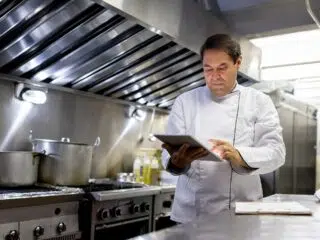How Restaurants Are Using AI
How five top restaurant brands are using ai to innovate operations, enhance customer experiences, and drive growth.
AI in restaurants is skyrocketing. As in other industries, early adopters are leveraging AI technology to gain a competitive advantage in the market. Whether automating processes, deriving greater insights, or expediting service, the potential of AI for restaurants is enticing and just scratching the surface of what’s possible.
Here we’ll review how some of the largest brands are using or testing AI in their operations today:

IHOP — Leaning into Online Ordering with AI Recommendations
The International House of Pancakes is a long-standing diner and breakfast chain with over 1,800 locations nationwide. As online ordering through applications like GrubHub and DoorDash grew in popularity, IHOP found a new audience and is now investing further into delivery and takeout. Today, takeout and delivery represent 20% of total sales across the US.
To increase revenue in these channels, IHOP deployed personalized online menus using Google’s Recommendation AI and BigQuery software. The AI tool analyzes a customer’s past ordering history to recommend dishes they might prefer. For example, the menu may promote menu items within a preferred price range or a dish with similar flavors to their past orders.
The goal of a personalized online menu is two-fold. First, it provides the customer a more convenient experience. Dishes most likely to be ordered by the customer are presented first, allowing a streamlined path to submitting the order. Further, the upsell opportunity of likely food pairings, beverages, sides, and desserts is expected to increase revenue in digital channels.
“Our new partnership with Google Cloud infuses AI into IHOP’s online ordering experience, making it even easier for our guests to place online orders, quickly find the items they love, and discover our newest products relevant to their individual tastes and interests.”
— Kieran Donahue, Chief Marketing Officer
Wendy’s — AI Drive-Thru Chatbot
Wendy’s joins several other major fast food chains in piloting AI chatbots for their drive-thru experience. The national burger chain announced that it would be expanding its artificial intelligence partnership with Google by allowing franchisees to test the “FreshAI” chatbot at their locations.
The experience will remain remarkably similar to what the customer is familiar with. They will drive their car up to the ordering intercom at which point an AI-generated chatbot will welcome them to Wendy’s. The customer interacts with the chatbot in much the same way they would associate and collect their food at the normal drive-thru window.
Early results report that the experience with an AI bot was 22-seconds faster than the local market average, and 86% of orders were fielded without intervention by the staff. Wendy’s is optimistic that these metrics will improve with time and further AI innovation.
“We created Wendy‘s FreshAI to overcome the challenges traditional AI could not solve in the drive-thru, including understanding casual conversation with customers and handling Wendy’s menu full of customizations and configurations.”
— Matt Spessard, Chief Information Officer
Domino’s Pizza — AI Assistant for Incoming Phone Orders
Domino’s Pizza has long been an innovator and early adopter of digital technologies to enhance the guest experience. From their online pizza tracker, which informs customers on the status of their order, to a mobile game that highlights how customers can order through the phone, online, or in-store channels, Domino’s is leveraging technology to differentiate itself in a crowded fast food and pizza market. On the customer side, an AI assistant hopes to offer a more “human-like” digital ordering process that will both deliver greater order accuracy as well as a preferred experience.
“We are thrilled to co-innovate with Microsoft using Azure AI technology to advance the future of pizza ordering and store technology powered by secure, connected data and simplified processes.”
— Kelly Garcia, Domino’s Executive Vice President and Chief Technology Officer
Chili’s Grill and Bar — AI Forecasting
Chili’s Grill and Bar, owned by Brinker International, leveraged AI to improve their forecasting accuracy in partnership with Fourth. After COVID-19, high turnover and less tenured management caused imbalanced forecasting accuracy across their 1200 locations.
Chili’s used Fourth’s AI forecasting and their 20+ years of HotSchedules data to build a strong forecasting model that increased forecasting accuracy by 20% and saved 600 labor hours per week across their 1200 locations. A more accurate forecast, generated with less time and admin for management, plus a schedule built with better labor optimization, reduced management turnover below industry average and facilitated better guest and employee experiences.
“AI forecasting is a game changer. An accurate forecast is foundational, it drives our actions to make sure we get a good team and guest experience”
– Jason Noorian, Brinker International’s VP Asset Management
Kentucky Fried Chicken — Facial Recognition at In-Restaurant Kiosks
Though many restaurants now offer on-site kiosks for self-service ordering, KFC has infused AI into the ordering experience. KFC China partnered with Chinese search engine giant, Baidu, to implement facial recognition and AI as part of a “smart restaurant” initiative.
Customers will approach a kiosk on location and access a digital menu where they may select their meal, customize their order, and submit payment. Like IHOP’s AI-powered online menu, KFC’s kiosk will serve up recommendations based on past order history. These recommendations will include the individual’s favorite menu items and recent orders. While a smart online menu will recognize the user based on their email address, account, or though browser cookies, the kiosks at KFC will use facial-recognition technology to analyze the patron and access any relevant data, such as mood indicators, age, and gender to inform their personalized menu and recommendations.
“Our innovations make use of the cutting-edge technologies, and they will help to attract more young consumers who prefer fashionable new things. The digitalization of the restaurant will also help to provide faster and easier services.”
– Zhao Li, General Manager of Beijing KFC
How AI Will Transform Restaurants
Fourth’s CTO, Christian Berthelsen, discusses how the first AI platform purpose-built for restaurants can change the game.
 By
By